Ozon, François – Senses of Cinema (original) (raw)
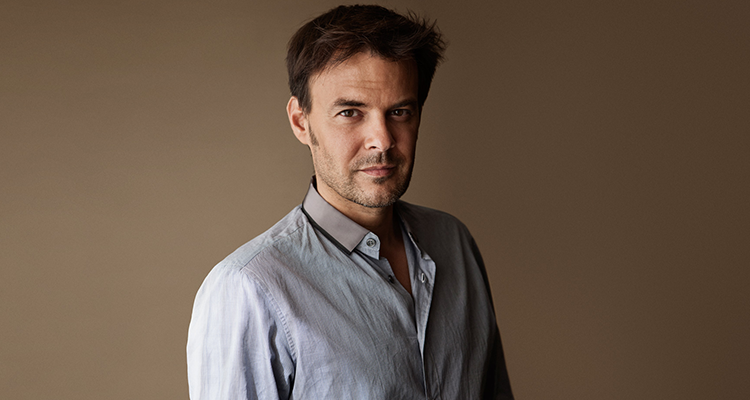
b. November 15, 1967, Paris, France
filmography
bibliography
web resources
Occasionally referred to as the enfant terrible of French cinema, François Ozon has in but a few years acquired a solid reputation as an original, successful and provocative (or thought-provoking, depending on one’s tastes) filmmaker, both in France and abroad. The speed at which he releases his films (at least one a year) is enough to make him noteworthy. If Ozon’s motion pictures are all varying in genre, content and form, they continuously challenge the rules of conventional cinema by tackling taboo issues of various kinds, including same-sex desires. Ozon does not confine himself to gay issues, but their recurrence, coupled with the director’s self-proclaimed homosexuality, make his status in French filmmaking fairly unusual, and therefore, worthy of attention.
Born in Paris shortly after the decline of the nouvelle vague, Ozon studied cinema both at the Université de Paris I, where he obtained a master’s degree, and at the prestigious FEMIS, under the tutelage of Eric Rohmer and Cahiers du cinéma critic/filmmaker/actor Jean Douchet (whom he chose for the part of the psychotherapist in his first full-length film). During this period, and throughout the 1990s, he tested his skills with an impressive number of shorts (a total of fourteen), and a 52 minute film (Regarde la mer/See the Sea, 1997), experimenting with super-8, video, 16mm and 35mm, until Sitcom, his first feature film, in 1998. He has since shot an additional two shorts, and five more feature films. His latest feature, 5X2, is set for release in late 2004.
A recent trend in French cinema, which can be seen alongside contemporary political debates on gay rights, offers less heterocentric visions of the world, and suggests sexual fluidity in new, innovative ways. André Téchiné can be regarded as a precursor of and main participant in this tendency, with film such as J’embrasse pas (I Don’t Kiss, 1991), Les Roseaux sauvages (Wild Reeds,1994) and Les Voleurs (Thieves, 1996). Other key works include Josiane Balasko’s Gazon maudit (French Twist,1995), Alain Berliner’s Ma vie en rose (My Life in Pink, 1997), Benoît Jacquot’s L’Ecole de la chair (The School of Flesh, 1998) and Catherine Corsini’s La Répétition (2001). Many of François Ozon’s shorts belong to this category, along with a number of his feature-length films, including Sitcom, Les Amants criminels (Criminal Lovers, 1999), Gouttes d’eau sur pierres brûlantes (Water Drops on Burning Rocks,2000) and 8 femmes (8 Women, 2002).
Ozon’s originality lies in his filmmaking style, which belongs to familiar cinematic traditions, but which he renders unfamiliar by either carrying them into queer territory, or by mixing up various recognisable genres within a single film. In doing so, he evinces a reticence to conform or fit inside the neatly delineated boundaries of mainstream cinema. Ozon’s works, from the very start, problematise identity as fixed, and destabilise notions of gender (masculinity, femininity) and sexuality in a daring and explicit fashion.
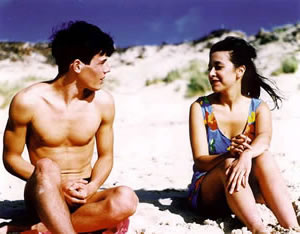
His critically acclaimed 1996 short film Une Robe d’été (A Summer Dress) rarely discussed by critics and scholars, deserves attention. The film opens in a close-up shot of a speedo-wearing young man’s crotch, revealing Ozon’s desire to present the male body and male sexuality distinctly and precisely in contemporary French cinema. This fifteen-minute tour de force tells the story of a bored eighteen-year-old man – on vacation with his boyfriend – who decides to go to the beach alone one afternoon (he is clearly irritated at his boyfriend’s singing and dancing to a song by French gay icon Sheila). He rides his bike to a deserted beach, strips naked, and goes for a swim into the ocean. When drying out in the sun, a Spanish woman asks him for a light for her cigarette and without further ado suggests that they could go have sex in the woods. He agrees, and afterwards, he confesses that he had never slept with a woman before. She asks if he is gay, and he replies, “Non, non, c’est juste que je suis en vacances avec un copain, et des fois…” (No, no, it’s just that I’m on vacation with a (male) friend, and sometimes…), thereby showing that he is unsure of his sexual orientation. The “robe” of the title becomes pivotal when, back on the beach, he realises that his clothes have been stolen: he is forced to wear the Spanish woman’s dress home. Upset at first, he gets used to the idea, and even comes to enjoy it. Gender “fluidity” is suggested literally as the fabric of the dress undulates in the wind as he is riding his bicycle back to his bungalow. He relishes the impromptu cross-dressing so much that he does not take off the dress when he gets home, which also happens to arouse his boyfriend sexually. In the end, after he is shown sewing the dress which had ripped in the heat of the action, his one-afternoon stand tells him that she does not want the dress back: “Je te l’offre, elle peut te servir” (It’s yours, you might want to use it again).
Une Robe d’été is a one of a kind experience in French cinema, as it suggests both gender and sexual fluidity. It portrays characters who are not forced to choose between the inevitable masculine/feminine and gay/straight binaries, nor are they ever punished for the choices they make. Ozon is fully aware of the guilt-free character of the film, which deliberately contrasts with his earlier guilt-ridden short, La Petite mort (1995): “It is, as I wanted it to be, a joyful and colourful film about summer which deals with the sexual ambivalence of teenage years, free of guilt” (1). Thierry Jousse, in Cahiers du cinéma, praised the film for its uniqueness: “It is a summery sexual comedy about the articulation of adolescent desire, presented with insolence, humour, lightness, frankness, elegance, poetry, a combination which is extremely rare in French cinema” (2).
When compared to some of his earlier shorts, Ozon’s first full-length film is a disappointment_._ The title (Sitcom) is a direct reference to American, but also, and especially, French situation comedies, which usually take place in a bourgeois setting, and which are often laden with conservative family values. The film’s intentions are clearly to subvert and transgress the norms of middle-class bonne société, as it explicitly presents or suggests every perversion and taboo in the book: homosexuality, interracial adultery, sadomasochism, incest, paedophilia, group sex, even bestiality. A laboratory rat recently brought to the home by the father turns out to be directly responsible for the chaos (its “negative vibrations” are blamed), and, after the death of the rat, and of the father, order is re-established in the end.
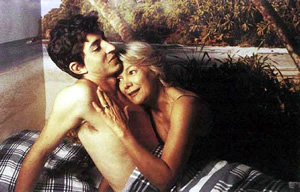
Critics have not been kind to Sitcom, and most criticism is geared towards the film’s gratuitous intention to shock, and its lack of clear message or motivation behind the perversions. After stating that transgressive cinema “ain’t what it used to be,” Richard Falcon writes “Sitcom plays every sexual combination it can with its characters,” and asks “[A]re we meant merely to be congratulating ourselves on recognising the kitsch-camp sensibility of a European John Waters fan? Or is Ozon, deep down, really expecting us to be shocked?” (3). What is surprising is that the film reminds him of cinema from another time period: the late 1950s and early 1960s. He writes, not without sarcasm, “If the shots survive intact we may look back on these films as the pre-millennial equivalent of the European art films of the late 50s and early 60s which drew audiences partly through their introduction of screen nudity and relative sexual candour” (4). Falcon does not mention directors’ names, or countries, and it is difficult to determine whether he is talking about the French nouvelle vague (which was indeed criticised for showing people “always in bed”) or other national cinemas.
Jonathan Romney suggests that Ozon’s inspirations are not to be found in Gallic cinema, and sees other influences besides John Waters, such as Luis Buñuel, Joe Orton and Pedro Almodóvar. He recognises, however, Ozon’s originality in his tackling of gay themes: “The film belongs in the by now altogether cosy cinematic tradition of épater les bourgeois, although Ozon is perhaps the first to ‘out’ the tradition, taking it to queer territory” (5). In the end, Romney is just as unimpressed as Falcon, as he writes, towards the end of his review: “It’s hard to know quite what Ozon is offering beyond the standard lampooning of repression. It’s hardly that taboo-busting to reveal that under the squeaky-clean appearance everyone’s up for a romp with the domestics and a fistful of courgettes” (6).
What is fundamentally problematic in Sitcom is not so much its intention to shock, but rather that in this plethora of perversions, homosexuality is treated on the same level as paedophilia, group sex and other perversions, thus reinforcing the already firmly established homophobic stereotype that gay men have loose morals and are all sexually turned on by young boys. If, as in Une Robe d’été, sexual fluidity is suggested, the suggestion is a lot more questionable. After David, the son of the family protagonists in Sitcom, comes out to his parents at the dinner table, and goes to his room, Abdu, the Spanish maid’s black husband, is summoned to go talk to him, as “he knows how to talk to kids” because of his job as a gym teacher (another stereotype which equates black men with athleticism). After Abdu is bitten by the rat, he comes on to David, and they kiss and fondle each other. Later in the film, Abdu loses his job because of allegations of child molestation, and leaves his wife because he realises that he is gay (his wife mentions to the mother of the family that he has been gay “for a little while”). In the last scene, Abdu shows up hand in hand with David at the father’s funeral, suggesting that the two of them are now in a relationship. Another interesting twist is that the maid and the mother of the family also show up together, suggesting a potential lesbian affair. If, in the end, the death of the patriarch has made everyone resolutely happier, and able to live their lives more freely, the process used to achieve this goal (i.e. the remaining seventy-eight minutes of the film) has shown homosexuals and black men in a less than satisfying light (7).
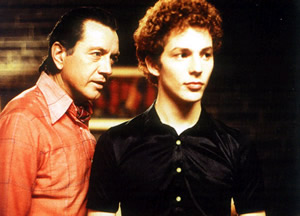
Ozon’s third feature, Gouttes d’eau sur pierres brûlantes is a huis clos,in the same fashion as Sitcom and 8 femmes (8). Adapted from an obscure play by Rainer Werner Fassbinder (Tropfen auf heisse Steine), it takes place in 1970s Germany, and recounts an unusual romance between a fifty-year-old businessman (Bernard Giraudeau) and a young student (Malik Zidi). The nature of the relationship is in accordance to all of Ozon’s films, as the boundaries between gay and straight are once again made fluid. The student reunites with his girlfriend (Ludivine Sagnier, who will become Ozon’s muse), and Giraudeau’s ex-lover Vera (Anna Thomson) also shows up at the apartment’s door, turning the relationship into a complicated ménage-à-quatre. The tone is darker than that of Sitcom, but comic relief is provided thanks to a campy, unexpected, perfectly choreographed musical sequence, which is a nice prelude to 8 femmes, his more elaborate “pseudo-musical”.
8 femmes is a lot more polished. Inspired by George Cukor’s The Women (1939), and adapted from a relatively unknown French boulevard play by Robert Thomas, the film clearly refuses to fit inside the boundaries of a single genre: it is a comedy, a melodrama and a whodunit, seasoned with a pinch of the musical. The death of the father, which occurs at the end of the story in Sitcom, is now at the centre of the narrative, as he is assassinated (or so we think) at the beginning of the film. Jean-Marc Lalanne makes an interesting observation about the representation of the father in Ozon’s work, as he notices that his films only tell two kinds of stories: the omnipotence of abusive fathers (the paedophile ogre in Les Amants criminels, Bernard Giraudeau ruling a submissive harem-like family in Gouttes d’eau sur pierres brûlantes) or, in contrast, the madness and chaos that the disappearance of the father brings about (Sitcom, Sous le sable and 8 femmes) (9).
8 femmes is visually stunning, colourful (paying homage to 1950s Hollywood Technicolor) and shamelessly stars the crème de la crème of French cinema. Each character gets to sing a musical number (often, but not always, relevant to the diegesis) and, if all eight women are shown as spectacles to be looked at (especially during the musical numbers), all of this occurs without the presence of a mediating male gaze. Shortly before the father is found dead, the first musical number, sung by the youngest sister (Ludivine Sagnier), clearly establishes the father as an outdated concept: “Papa, t’es plus dans le coup”, which roughly translates as “Daddy, you ain’t with it any more.” The film’s final twist, however, reveals that the father, alive and well, has been hiding in his room all along, listening to and looking at what went on in and around the house – one even sees him peeking out the window, into the front yard. Disgusted at the behaviour of his wife, sister, sister-in-law, older daughter, mother-in-law and maids, he finally commits suicide in front of his younger daughter, who was his accomplice in the fake murder ploy.
As could be expected from Ozon, the film also contains a lesbian, again interracial, intrigue (as in Sitcom): the maid Madame Chanel (Firmine Richard) is having an affair with the father’s sister Pierrette (Fanny Ardant), who is hated by the wife and mother of the family Gaby (Catherine Deneuve). After the affair is uncovered, Deneuve and her mother (Danielle Darrieux) are appalled at the idea of having an invertie (invert) in the house and the maid withdraws to the kitchen. Her musical number follows, as she, alone in the kitchen, sings a song entitled “Pour ne pas vivre seul” (So as not to live alone). The song is about lonely people who would do anything not to be on their own (some get a dog, some worship a cross, etc.). The second verse acknowledges that same-sex relationships occur for the same reason: “Pour ne pas vivre seul, des filles aiment des filles, et l’on voit des garçons épouser des garçons” (So as not to live alone, girls love girls, and sometimes, boys marry boys). Most of the musical numbers appear to be aimed at revealing the characters’ true inner thoughts. However, it remains unclear whether the film seems to suggest that Madame Chanel herself became a lesbian out of sheer loneliness, or whether the line pokes fun at assumptions about homosexual desire.
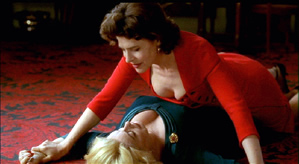
The apparently random, somewhat unexpected, lesbian kiss between Pierrette and Gaby, which occurs later in the story, is equally difficult to interpret. One can think of mere shock value or even comic relief (when the rest of the women walk in on them). Lalanne shrugs off the homosexual nature of the embrace, and advances that what we see is not two women kissing, but rather two icons of François Truffaut’s cinema, two “images” which come together for an instant (10). David Ehrenstein, author of Open Secrets: Gay Hollywood 1928-2000, suggests that “that embrace isn’t meant to examine same-sex passion so much as it is to recall plush A-picture romance in all its Hollywood glow” (11). I agree that one should not take the romp (and it is a romp) too seriously, and that the answers to _8 femmes_‘ questions should be found in intertextuality rather than rationality. Viewed in this light, Deneuve and Ardant’s fight merely “cites” La Femme d’à côté (The Woman Next Door,Ardant’s first film with husband Truffaut, 1981), and the kiss that ensues is more meant to recall Tony Scott’s The Hunger (1983) and Téchiné’s Les Voleurs, in which Deneuve plays a lesbian character.
Ozon’s ardent cinephilia is present in most of his films: Sitcom is very Buñuelian, but it can also be seen as a modern remake of Pier Paolo Pasolini’s Teorema (1968), and Les Amants criminels shamelessly quotes Charles Laughton’s The Night of the Hunter (1955). The director’s cinephilia is most manifest in 8 femmes, in which the intertextual references are too numerous to count. The scenario indicates that the film pays homage to 1950s Hollywood films directed by exiled European directors (12). One can think of Douglas Sirk’s melodramas (the film particularly quotes All that Heaven Allows, 1956), as well as the primary coloured musicals of (non émigré) Vincente Minnelli. _8 femmes_‘ actresses and costumes pay tribute to stars of classic Hollywood: Lana Turner and Marilyn Monroe (Deneuve), Agnes Moorehead (Isabelle Huppert), Kim Novak and Grace Kelly (Emmanuelle Béart), Rita Hayworth (Ardant), Audrey Hepburn (Virginie Ledoyen), Leslie Caron (Sagnier), Hattie McDaniel and Juanita Moore (Richard).
If the film has the “look” of 1950s Hollywood cinema, it is also deeply rooted in the French cinematic tradition. I have already mentioned the connection with Truffaut’s films (and his real life, as Deneuve was also involved romantically with the director). During a mother-daughter talk between Deneuve and Ledoyen, the mother repeats a line (“c’est une joie, et une souffrance”) said to her in two films by Truffaut (La Sirène du Mississippi [1969] and Le Dernier métro [1980]). The abnormally-long (twenty-two second) close-up shot of Ardant (who overheard the line) suggests that it is the memory of her late husband which brings her to tears rather than the fictional context of the film (13). 8 femmes also indirectly makes reference to three previous films in which Deneuve and Darrieux were mother and daughter (including Jacques Demy’s Les Demoiselles de Rochefort [1967] and Téchiné’s Le Lieu du crime [1986]), and two films in which Darrieux was a poisoner (Henri Decoin’s La Vérité sur Bébé Donge [1952] and L’Affaire des poisons [1955]). One last example: Ledoyen hides her pregnancy in 8 femmes, as she did in Claude Chabrol’s La Cérémonie (1995).
The film encyclopaedia to which 8 femmes can be compared contrasts with the profoundly original works which I would like to call Ozon’s “trilogy on female desire”: Regarde la mer (1997), Sous le sable (Under the Sand, 2000) and Swimming Pool (2003). Made three years apart from one another, the three films have much in common. Slow in pace, they feature an English woman in the main role (Sasha Hails in the first one, Charlotte Rampling in the last two), and take place by the water, in a vacation setting. In all three cases, the women have to deal with the absence of a male figure (a husband or a lover). In all three cases, their sexual urges are made explicit, either through masturbation scenes or actual lovemaking with strangers or flings. In all three cases, someone is killed.
Frédéric Bonnaud recognises the connection between the first two films, as he calls Regarde la mer a “rough draft” of Sous le sable (14). I would like to point out a cinematic connection between the last two films, as the opening shot of Swimming Pool (a high angle shot of the river Thames in London) quotes the opening shot of Sous le sable (a high angle shot of the river Seine in Paris). In Sous le sable, the camera pans down to the water after showing a view of Notre-Dame, and in Swimming Pool, the camera pans up from the water to show a view of the Parliament. In both cases, the title of the film appears on top of the water, in capital letters, in the same font (15).
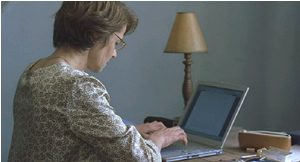
In their depiction of desire, Sous le sable and Swimming Pool are as subtle as some of Ozon’s earlier works (Sitcom, Les Amants criminels) are heavy. The first film tells the story of a woman who refuses to admit the death of her husband (played by Bruno Cremer, Rampling’s screen partner in Patrice Chéreau’s 1975 La Chair de l’orchidée [_Flesh of the Orchid_]), and goes on with her life as though he were still alive. The second film is about a repressed English murder-mystery novelist (named Sarah Morton) who travels to the Lubéron in search of inspiration for a new book. The trip is more than fruitful, and she ends up writing what is probably the best book of her career. Ozon slowly eases the spectator into the story, and lets him/her participate in the writing process as much as Rampling herself. Never before had the spectator entered the mind of a character with such intensity as in Swimming Pool. Saying more would be revealing the deliciously clever end to the story.
Swimming Pool is possibly Ozon’s most accomplished (and most personal) work. Ozon willingly admits that he is Sarah Morton (just as Flaubert declared that he was Madame Bovary), and that the film is in fact about his own creative method. If one cannot help but compare Swimming _Pool_‘s murder scene to Henri-Georges Clouzot’s Les Diaboliques (1955), most of Ozon’s inspirations for the film are to be found… in his own cinema:
Swimming Pool _reflects my personal obsessions about creating, and, since it’s a film about inspiration, contains many references to my other work. [The] caressing shot [in which the camera pans slowly from a character’s feet to face] is also in [_Gouttes d’eau_]. The relationship between Ludivine [Sagnier] and Charlotte [Rampling] refers back to [8 femmes_]. Swimming Pool _also resembles [Sous le sable_], since both those women live in their heads (16).
Ozon’s next project, 5X2, returns to the heterosexual couple (as in Sous le sable): “It’s about five important moments in the life of a couple [played by Valeria Bruni Tedeschi and Stéphane Freiss]. Like Bergman’s _Scenes from a Marriage_” (17). Knowing Ozon, I doubt it will be your typical boy-meets-girl, boy-marries-girl story.(18)
Filmography
Photo de famille (1988) short
Les Doigts dans le ventre (1988) short
Mes parents un jour d’été (1990) short
Une Goutte de sang (1991) short
Le Trou madame (1991) short
Peau contre peau (1991) short
Deux plus un (1991) short
Thomas reconstitué (1992) short
Victor (1993) short
Une Rose entre nous (1994) short
Action vérité (Truth or Dare) (1994) short
La Petite mort (1995) short
Jospin s’éclaire (1995) documentary
Une Robe d’été (A Summer Dress) (1996) short
Regarde la mer (See the Sea) (1997) short
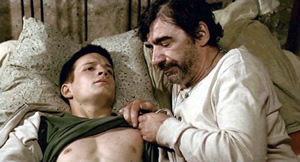 Sitcom (1998)
Sitcom (1998)
Scènes de lit (1998) short
X 2000 (1998) short
Les Amants criminels (Criminal Lovers)(1999)
Gouttes d’eau sur pierres brûlantes (Water Drops on Burning Rocks) (2000)
Sous le sable (Under the Sand) (2000)
8 femmes (8 Women) (2002)
Swimming Pool (2003)
5×2 (2004)
Le Temps qui reste (Time to Leave) (2005)
Un Lever de rideau (A Curtain Raiser) (2006) short
Angel (2007)
Ricky (2009)
Le Refuge (Hideaway) (2009)
Potiche (Trophy Wife) (2010)
Dans la maison (In the House) (2012)
Jeune et jolie (Young and Beautiful) (2013)
Une Nouvelle amie (The New Girlfriend) (2014)
Frantz (2016)
L’amant double (Amant Double) (2017)
Bibliography
Andrew Asibong, “François Ozon”, Manchester, Manchester University Press, 2008.
Patrick Blouin, “La Place du mort”, Cahiers du cinéma, 554, February 2001, pp. 76–78.
Frédéric Bonnaud, “François Ozon: Wannabe Auteur Makes Good”, Film Comment, vol. 37, no. 4, July–August 2001, pp. 52–55.
Max Cavitch, “Sex After Death: François Ozon’s Libidinal Invasions,” Screen 48.3, Autumn 2007, 313-326. (http://www.english.upenn.edu/~cavitch/pdf-library/Cavitch_Sex_after_Death.pdf
Laure Charcossey, “Les Magiciens d’Ozon”, Cahiers du cinéma, 556, April 2001, pp. 44–45.
David Ehrenstein, “They Sing, They Dance, They Kill”, Advocate, 873, 1 October 2002, p. 60.
Richard Falcon, “Reality Is Too Shocking”, Sight and Sound, vol. 9, no. 1, January 1999, pp. 10–13.
Erwan Higuinen, “Avoir un projet d’avance”, Cahiers du cinéma, 544, March 2000, pp. 39–41.
Kate Ince, ed. “Five Directors: Auteurism from Assayas to Ozon”, Manchester, Manchester University Press, 2011.
Sheila Johnston,” Death Every Day”, Sight and Sound, vol. 11, no. 4, April 2001, pp. 12–13.
Thierry Jousse, “Ozon!”, Cahiers du cinéma, 505, September 1996, p.12.
Thierry Jousse, “Sans toit ni loi”, Cahiers du cinéma, 519, December 1997, pp. 66–67.
Jean-Marc Lalanne, “Les Actrices: Huit Femmes de François Ozon”, Cahiers du cinéma,565, February 2002, pp. 82–83.
Jean-Marc Lalanne, “La Place du père et celle du rat”, Cahiers du cinéma, 524, May 1998, pp. 107–108.
Stéphane Malandrin, “Bang Bang à Pantin”, Cahiers du cinéma, 505, September 1996, pp. 12–13.
François Ozon, 8 femmes, Paris, La Martinière, 2002.
François Ozon, 8femmes_: Scénario_, Paris, La Martinière, 2002.
François Ozon, Sous le sable, Paris, L’Arche, 2001.
François Ozon, Swimming Pool, Paris, L’Arche, 2003.
Thibaut Schilt, “François Ozon”, Urbana, University of Illinois Press, 2011.
Charles Tesson, “Eau plate”, Cahiers du cinéma, 579, May 2003, pp. 48–49.
Ginette Vincendeau, “Ageing Cool”, Sight and Sound, vol. 13, no. 9, September 2003, pp. 27–28.
Web Resources
François Ozon Official website
Zeitgeist films | François Ozon Independent American distributors that carry several titles
Identity and Love An article on Ozon from Kinoeye (mostly on Gouttes d’eau)
8 femmes French site including an interview with Ozon for 8 femmes.
Fantasy, Reality, Creation An interview with Ozon on Swimming Pool
Endnotes
- François Ozon, “Entretiens à propos des courts-métrages”, François-Ozon.com,
http://www.francois-ozon.com/fr/entretiens-les-courts-metrages. The translation is mine.
- Thierry Jousse, “Ozon!,” Cahiers du cinéma, 505, Sep. 1996, p. 12. The translation is mine.

- Richard Falcon, “Reality Is Too Shocking”, Sight and Sound, vol. 9, no. 1, January 1999, p. 10.

- Falcon, p. 11.

- Jonathan Romney, “_Sitcom_“, Sight and Sound, vol. 9, no. 1, January 1999, p. 56.

- Romney, p. 56.

- Ozon’s later Les Amants criminels is not any more satisfying from that standpoint: it tells the story of a gay hermit who sexually abuses a younger man.

- A huis clos is a play or film which takes place in a single setting (often a confined room, or a remote mansion from which you cannot escape).

- Jean-Marc Lalanne, “Les Actrices: Huit Femmes de François Ozon”, Cahiers du cinéma,565, February 2002, p. 83. Lalanne is not entirely right when he claims that the father has disappeared in Sitcom. As we have seen, he is only killed off in the end.

- Lalanne, p. 83.

- David Ehrenstein, “They Sing, They Dance, They Kill”, Advocate, 873, 1 October 2002, p. 60.

- François Ozon, 8 femmes: Scénario, Paris, La Martinière, 2002, p. 5. Also see the book of pictures (same editor, same year) for more intertextual references.

- Lalanne, p. 82.

- Frédéric Bonnaud, “François Ozon: Wannabe Auteur Makes Good”, Film Comment, vol. 37, no. 4, July–August 2001, p. 53.

- Ryan Gilbey also noticed the similarity in his review of Swimming Pool (Sight and Sound, vol. 13, no. 10, October 2003, p. 64). Also, _Regarde la mer_‘s opening shot shows gentle waves brushing against a sandy beach. At times, the water fills up the whole screen, in the same fashion as the last two films of the trilogy.

- Erica Abeel, “François Ozon on Swimming Pool: Fantasy, Reality, Creation”, IndieWire, http://ericaabeel.com/film_pieces.html#3

- See Abeel’s interview with Ozon.

- Since the 2004 publication of this piece in Senses of Cinema, two books (by this author, Thibaut Schilt, and Andrew Asibong) and one book chapter (by Kate Ince) have been released on the cinema of François Ozon. Please consult the updated bibliography on this page for full references. The filmography has also been updated to reflect Ozon’s body of work up to 2014.
